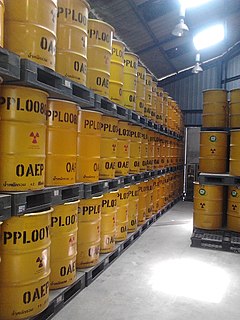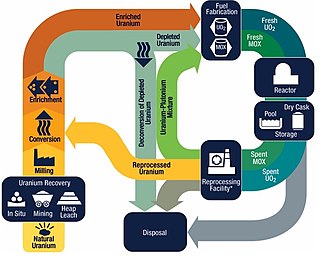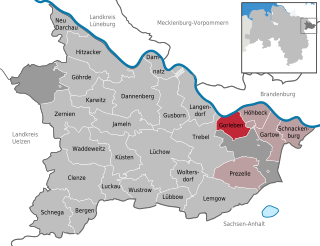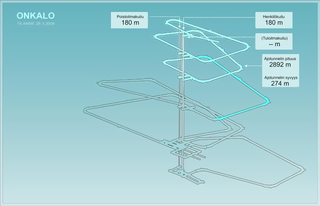Illustration
In the diagram the solution domain is used for the purpose of computer modelling of heat flow around the borehole. [6]
 |
Deep borehole disposal (DBD) is the concept of disposing high-level radioactive waste from nuclear reactors in extremely deep boreholes instead of in more traditional deep geological repositories that are excavated like mines. Deep borehole disposal seeks to place the waste as much as five kilometres (3 mi) beneath the surface of the Earth and relies primarily on the thickness of the natural geological barrier to safely isolate the waste from the biosphere for a very long period of time so that it should not pose a threat to humans and the environment. The concept was originally developed in the 1970s, but in 2014 a proposal for a first experimental borehole was proposed by a consortium headed by Sandia National Laboratories. [1]
The waste would be put into the lower mile of such a hole, within crystalline rock to isolate it from the environment. [2] The upper two miles of the borehole would be filled with protective layers including asphalt, bentonite, concrete and crushed rock that are expected to protect the environment during geologic time, and the hole would be lined with steel casing. [2]
A pair of proposed test boreholes in the United States were cancelled due to public opposition and lack of funding in 2016 and 2017.
Beginning in 2016, the U.S. Department of Energy funded an experimental borehole extending over 3 miles (5 km) deep, in Rugby, North Dakota. The plans for this five-year project in Rugby did not involve nuclear waste, and instead would have tested other aspects of the borehole concept. [3] However, following protests in North Dakota, a site was proposed in Spink County, South Dakota. After protests in South Dakota prevented the project from moving forward, the Department of Energy scrapped the project. [4] Due to public opposition to the first experimental borehole, in late 2016 the Department of Energy announced a second project which would have involved four sites; two in New Mexico, one in Texas and one in South Dakota. The early stages of the project required gaining public support before the Department of Energy would have selected a final site for an experimental borehole. On 23 May 2017, the Department of Energy announced that funding priorities had changed and that the deep borehole project was de-funded. [5]
In the diagram the solution domain is used for the purpose of computer modelling of heat flow around the borehole. [6]
 |
Deep borehole disposal involves drilling a hole about 5 km (3 mi) down into the Earth's crust. High level waste, like spent nuclear fuel, would be sealed in strong steel containers and lowered down the borehole, filling the bottom one or two kilometers of the hole. Current technology limits the diameter of the borehole to less than 50 centimetres (20 in). This means that some waste currently stored in large containers would need to be repackaged in smaller containers. [1] The rest of the borehole is then sealed with appropriate materials, including clay, cement, crushed rock backfill, and asphalt, to ensure a low-permeability barrier between the waste and the land surface. In some concepts, waste may be surrounded by cementitious grout or a highly compacted bentonite buffer matrix to provide improved containment and to reduce the effect of rock movement on the canisters' integrity. A high-temperature scenario involves very young hot waste in the containers which releases enough heat to create a melt zone around the borehole. As the waste decays and cools, the melt zone resolidifies, forming a solid granite sarcophagus around the containers, entombing the waste forever. [7] Under both scenarios, chemically reducing conditions adjacent to the borehole will reduce the transport of most radionuclides.[ citation needed ]
The deep borehole concept can be applied to any amount of waste. For countries that do not rely on nuclear power plants, their entire inventory of high-level nuclear waste could perhaps be disposed of in a single borehole.[ citation needed ] Current estimates suggest that spent fuel generated from a single large nuclear power plant operating for multiple decades could be disposed of in fewer than ten boreholes.[ citation needed ] It is estimated that only 800 boreholes would be sufficient to store the entire existing nuclear waste stockpile of the US. [1] Borehole disposal programs could be terminated at any time with little loss of investment because each borehole is independent. The modular nature of borehole disposal would lend itself to regional, or on-site, disposal of nuclear waste. Another attraction of the deep borehole option is that holes might be drilled and waste emplaced using modifications of existing oil and gas drilling technologies.
Finally, the environmental impact is small. The waste handling facility at the wellhead, plus a temporary security buffer zone, would require about one square kilometer. When the borehole is filled and sealed, the land can be returned to a pristine condition.[ citation needed ]
Every state in the U.S. has deep rocks suitable for its own borehole repository. [2] The required crystalline basement rocks are located far below low-density sedimentary rock, drinking water aquifers, and oil and gas deposits. [2] A single borehole would not be big enough to hold all of the nuclear waste produced by a country like the United States, and therefore a number of them might eventually exist within a single country. [2]
Scientists at the University of Sheffield in England say that deep boreholes for nuclear waste disposal can be built much more quickly than a traditional deep geological repository that is excavated like an underground mine for waste disposal. [8] The mined repository approach has been pursued unsuccessfully for many years but the University of Sheffield engineers say that a borehole could be drilled, filled and sealed in no more than five years, in contrast to the decades required for a mined repository. [8]

Radioactive waste is a type of hazardous waste that contains radioactive material. Radioactive waste is a result of many activities, including nuclear medicine, nuclear research, nuclear power generation, rare-earth mining, and nuclear weapons reprocessing. The storage and disposal of radioactive waste is regulated by government agencies in order to protect human health and the environment.

The Yucca Mountain Nuclear Waste Repository, as designated by the Nuclear Waste Policy Act amendments of 1987, is a proposed deep geological repository storage facility within Yucca Mountain for spent nuclear fuel and other high-level radioactive waste in the United States. The site is on federal land adjacent to the Nevada Test Site in Nye County, Nevada, about 80 mi (130 km) northwest of the Las Vegas Valley.

The nuclear fuel cycle, also called nuclear fuel chain, is the progression of nuclear fuel through a series of differing stages. It consists of steps in the front end, which are the preparation of the fuel, steps in the service period in which the fuel is used during reactor operation, and steps in the back end, which are necessary to safely manage, contain, and either reprocess or dispose of spent nuclear fuel. If spent fuel is not reprocessed, the fuel cycle is referred to as an open fuel cycle ; if the spent fuel is reprocessed, it is referred to as a closed fuel cycle.

KBS-3 is a technology for disposal of high-level radioactive waste developed in Sweden by Svensk Kärnbränslehantering AB (SKB) by appointment from Statens Strålskyddsinstitut. The technology was developed by studying different natural storage facilities such as the natural reactor in Oklo, Gabon and the uranium mine in Cigar Lake, Saskatchewan, Canada. The general theory is that radioactive rock in these sites has been present for thousands of years, and has not affected the health and well-being of human populations. KBS-3 is also to be used in Finland at the Onkalo spent nuclear fuel repository, being built by Posiva.

The Waste Isolation Pilot Plant, or WIPP, is the world's third deep geological repository licensed to store transuranic radioactive waste for 10,000 years. The waste is from the research and production of United States nuclear weapons only. The plant started operation in 1999, and the project is estimated to cost $19 billion in total.
Ocean floor disposal is a method of sequestering radioactive waste in ocean floor sediment where it is unlikely to be disturbed either geologically or by human activity.

The Nuclear Waste Policy Act of 1982 is a United States federal law which established a comprehensive national program for the safe, permanent disposal of highly radioactive wastes.

A deep geological repository is a way of storing hazardous or radioactive waste within a stable geologic environment. It entails a combination of waste form, waste package, engineered seals and geology that is suited to provide a high level of long-term isolation and containment without future maintenance. This will prevent any radioactive dangers. A number of mercury, cyanide and arsenic waste repositories are operating worldwide including Canada and Germany and a number of radioactive waste storages are under construction with the Onkalo in Finland being the most advanced.

Gorleben is a small municipality (Gemeinde) in the Gartow region of the Lüchow-Dannenberg district in the far north-east of Lower Saxony, Germany, a region also known as the Wendland.
Nuclear entombment is a method of nuclear decommissioning in which radioactive contaminants are encased in a structurally long-lived material, such as concrete. This prevents radioactive material and other contaminated substances from being exposed to human activity and the environment. Entombment is usually applied to nuclear reactors, but also some nuclear test sites. Nuclear entombment is the least used of three methods for decommissioning nuclear power plants, the others being dismantling and safe enclosure. The use of nuclear entombment is more practical for larger nuclear power plants that are in need of both long and short term burials, as well as for power plants which seek to terminate their facility licenses. Entombment is used on a case by case basis because of its major commitment with years of surveillance and complexity until the radioactivity is no longer a major concern, permitting decommissioning and ultimate unrestricted release of the property. Considerations such as financial backing and the availability of technical know-how are also major factors.

High-level radioactive waste management concerns how radioactive materials created during production of nuclear power and nuclear weapons are dealt with. Radioactive waste contains a mixture of short-lived and long-lived nuclides, as well as non-radioactive nuclides. There was reportedly some 47,000 tonnes of high-level nuclear waste stored in the United States in 2002.
The Deep Geological Repository Project (DGR) was a proposal by Ontario Power Generation (OPG) in 2002 for the site preparation, construction, operation, decommissioning and abandonment of a deep geological radioactive waste disposal facility for low and intermediate-level radioactive waste (L&ILW). In 2005, the municipality of Kincardine, Ontario volunteered to host the facility located on the Bruce nuclear generating station adjacent to OPG's Western Waste Management Facility (WWMF). The facility would have managed L&ILW produced from the continued operation of OPG-owned nuclear generating stations at the Bruce, Pickering Nuclear Generating Station and Darlington Nuclear Generating Station in Ontario. In May 2020, after 15 years of environmental assessment, OPG withdrew its application for a construction license on Saugeen Ojibway Nation Territory.

The Gorleben salt dome is a proposed deep geological repository in a salt dome in Gorleben in the Lüchow-Dannenberg district in the far north-east of Lower Saxony for low-, medium- and high-level radioactive waste.

The pit Konrad is a former iron ore mine proposed as a deep geological repository for medium- and low level radioactive waste in the city Salzgitter in the Metropolitan region Hannover-Braunschweig-Göttingen-Wolfsburg in southeast Lower Saxony, Germany, located between Hildesheim and Braunschweig. It has two shafts: Konrad I and Konrad II.

Into Eternity is a 2010 Danish documentary film directed by Michael Madsen, released in 2010. It follows the construction of the Onkalo waste repository at the Olkiluoto Nuclear Power Plant on the island of Olkiluoto, Finland. Director Michael Madsen questions Onkalo's intended eternal existence, addressing an audience in the remote future.

The Onkalo spent nuclear fuel repository is a deep geological repository for the final disposal of spent nuclear fuel. It is near the Olkiluoto Nuclear Power Plant in the municipality of Eurajoki, on the west coast of Finland. It is being constructed by Posiva, and is based on the KBS-3 method of nuclear waste burial developed in Sweden by Svensk Kärnbränslehantering AB (SKB). The facility is expected to be operational in 2023.
The Czech Radioactive Waste Repository Authority (SÚRAO) was established on 1 June 1997 as a state organisation established by the Ministry of Industry and Trade. In 2001, SÚRAO assumed the status of a government agency. The Authority is headed by its managing director, Dr. Jiří Slovák. The governing body of SÚRAO consists of its Board which is made up of representatives from the government, radioactive waste producers and the general public. The managing director and members of the Board of SÚRAO are directly appointed by the Minister of Industry and Trade.
The Underground Research Laboratory was a test site for deep geological repository of nuclear waste operated by Atomic Energy of Canada Limited's (AECL's) Whiteshell Laboratories near Lac du Bonnet in Manitoba, Canada. The site was built inside a large granite batholith, typical of the Canadian Shield. The site was selected in 1980, construction began in 1982 and it opened in 1985. No radioactive material was stored at the site, it was used purely for measurements of water exchange, rock movement, and other issues that would affect the safety of such materials. The site was also used by a variety of international users. As part of the wider wind-down of AECL activities, the decision was made to close the URL in 2003. Cleanup work began in 2006 and completed in 2010. The site continues to host a single international experiment measuring water leakage through a massive clay plug.

Deep horizontal drillhole disposal is the concept of disposing of high-level radioactive waste from a nuclear reactor in deep horizontal boreholes instead of in more traditional deep geological repositories that are excavated like mines. The design concept is intended to improve upon the vertical borehole concept developed by Sandia National Laboratories, by utilizing modern advancements in directional drilling technology as well as using isotopic methods to measure the affinity a host rock has for isolation.
{{cite journal}}: Cite journal requires |journal= (help)